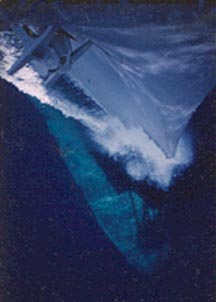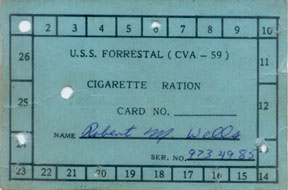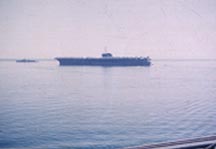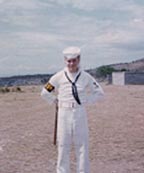BOB'S SEA TALES
Remembering the Med
The Forrestal was the first of what is known as the Forrestal Class Carriers. Therefore, it was a showboat. Everything shined. The quarterdeck where the ceremonies were held was a piece of boatswain mate ingenuity, with polished shell casings, knots and other works of art. The crew maintained spotless personal appearance, from haircut to spit shine. Not a spot of rust or oil could be found.Every silver lining has... The band was quartered with the Marine detachment. They were a surly lot assigned to guarding: special weapons, senior officers, and the brig. Many of them ended up the cruise having served time in the brig.
Not all Marines can be described as above. One, Corporal James E. Gooding, a big lovable Christian, who shared his Christmas with the unfortunate of Naples, actually saved my life one night. A drunk Marine got rowdy and determined to do in a bandsman. He picked me, and had the blade of his bayonet on my throat as I lay in my rack, feigning sleep. Cpl. Gooding came plodding up, and all I heard was, whap - thump, as he laid that Marine out cold and drug him away... Back to the Christmas story: Cpl. Gooding gave each of three poor Italian families, 22 people in all, a big Christmas dinner with gifts for everyone. If asked his reason he simply says, "I just wanted to do something like that so I did it. When I was back home in Brooklyn I used to dress up as Santa Claus on Christmas Eve and go up to the homes of some poor people and drop off presents and leave, just to show the poor kids that there really was a Santa Claus. I like to do things like that."
The sleeping quarters were one deck below the mess deck which was one deck below the hanger, about midship. The rehearsal space was up three decks above the hanger, then down one, (sort of like a dead-end street), at the aft end of the ship on the starboard (right). The library / instrument storage room was accessed by a vertical ladder down from the rehearsal room. There was also a small fan room accessed at the far end of the storage room where we stashed our souvenirs. We would also use this confined space to relieve the pressures of weeks at sea by dogging down the hatch and then screaming until the tension was gone. Hey, it worked!
I took the time to describe the band spaces to let you know that this area was completely destroyed in 1967 in brutal fire and explosions, off the coast of Viet Nam, which started when a zuni rocket from an F-4 Phantom launched and flew across the deck hitting a parked and armed A-4 Skyhawk piloted by Lt. John McCain, now a U.S. Senator from Arizona . Learn more by clicking July 29, 1967 on the Forrestal site.
"Sea Stores", were special tax-exempt cigarettes, wrapped in wax paper, and sold aboard ship only while at sea. The price was so low that they had to be rationed. I could only afford an occasional carton on my bi-monthly pay of $12.00. Some shipmates would secret many cartons ashore to be sold on the black market. The profit, some thought, was worth the risk of being caught. A 6th Fleet Band, French Horn player was caught trying to take a bass drum filled with cartons through customs in Naples. It was at night and the bright flood lights used by the inspectors did not penetrate through the drum heads; oops! I did not hear how he made out, but the Navy lost a good musician that night.
The Forrestal stories are not complete...planes and exciting places to visit are still to be told.
Following our experiences on the Forrestal, the band was assigned to Carrier Division Six aboard the USS Saratoga-CVA 60. The Saratoga, being second in it's class was a workhorse and it looked the part.We spent the summer in the Caribbean on training exercises, including several weekends in Gitmo Bay, Cuba. Castro may have controlled Cuba, but the US Navy maintained a long term commitment at Guantanamo. Shakedown cruises are made to test fleet readiness after extended repairs and rest. The ship conducted drills and equipment tests during the week and then returned to the Bay for the weekends. The flag staff planned a picnic at the fleet beach, which was a hot barren location with a questionable swimming beach. Hot dogs and hamburgers were the fare of the day. Each group was required to assign someone for shore patrol duty to maintain order. Since the beer would flowing I volunteered as I did not consume much. Well, we had a softball game scheduled and an umpire was needed. All hands looked my way since I would be able to call a quasi-honest game
.
Ah; so different was the following weekend when the band stationed at Gitmo invited us to a picnic at their beach. Doc Dillon was in charge; had too much spendable cash; and was an all-a-round weird guy. He prepared T-bone steaks for everyone. The beach had decent shelters from the sun, and boasted one of the finest swimming holes to be found anywhere. One word of caution was don't sit on the sea urchins, and watch out for the barracuda. That band had it all, but Castro was a constant threat.
Something happened to a propulsion shaft, (turns the propeller) and repairs were required. We had a deadline to relieve the command in the Med so loaded all band gear, personal gear and top secret flag gear onto the USS Essex-CV 9. The sleeping quarters were totally undesirable so we dragged our mattresses to the secondary control room where we kept the band instruments and gear and slept and existed there. Some nights we slept outside under the gun turrets. Anyway, we entered the Med on schedule and proceeded directly to a rendezvous with the ship we were relieving.
Later that month the repairs to the Saratoga were completed and it caught up to us. In the morning we would be in Polencia Bay on the island of Mallorca off the east coast of Spain. To get there we went between the islands of Menorca and Mallorca. The day before we stacked all the gear in the hanger bay (area for parking planes below flight deck and above waterline). That normally would be satisfactory, but this night the winds between the islands created swells judged to be 30 foot at times and the water came crashing into the hanger bay. When we were awaken at 3 am, everything was floating in 6 inches of water. We moved all the gear to a sandbagged area, being very careful not to bother the armed Marines who were guarding the top secret materials. The morning broke as we came around and began the entry into Polencia Bay. There were three carriers, cruisers, destroyers, submarines and a number of service force ships in the Bay. I would suspect we saw most of the fleet that day. The other ships at anchor already, were allowing their crews to swim off the ships. We were busy loading the utility boats and making our way over to the Saratoga. Just as soon as we got the last case aboard, all ships weighed anchor and away we went. I have always wondered why so many ships were in such a confined area, re: Pearl Harbor.



